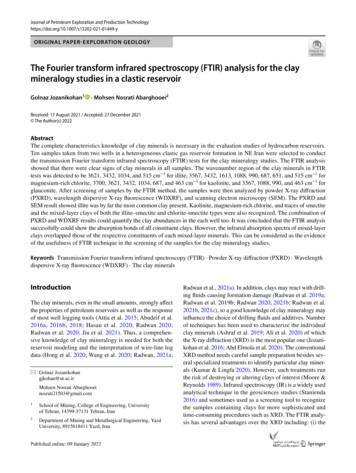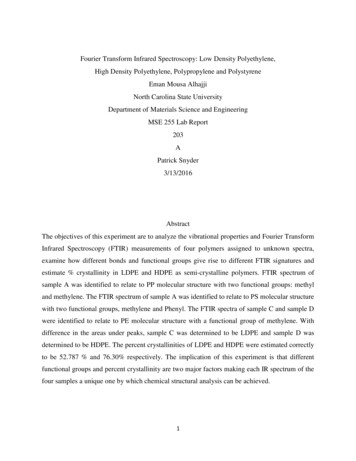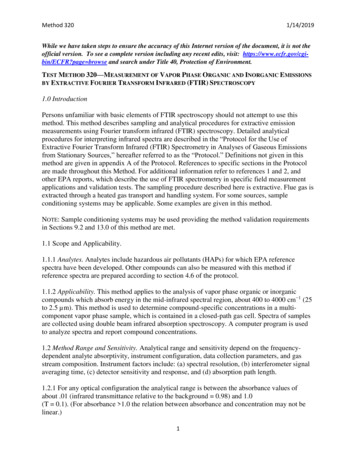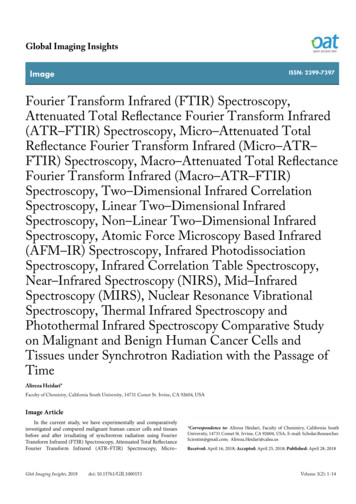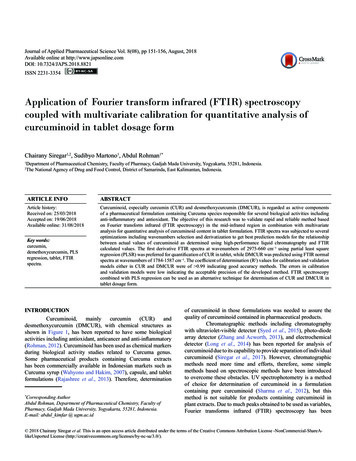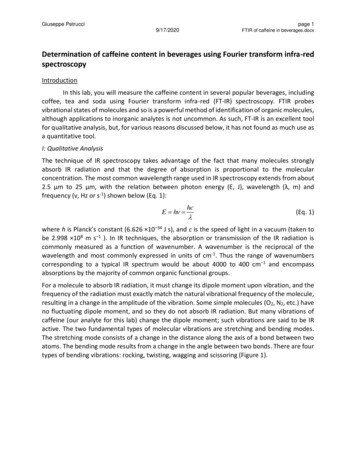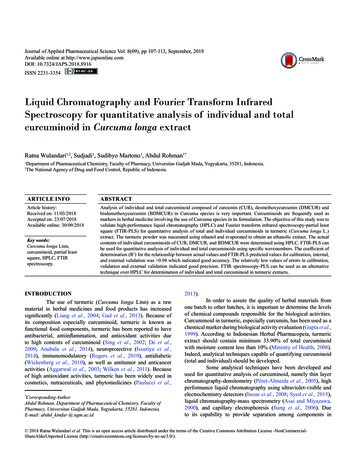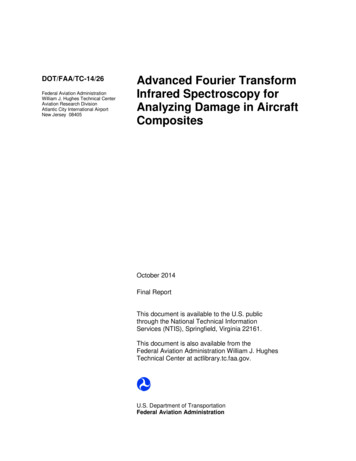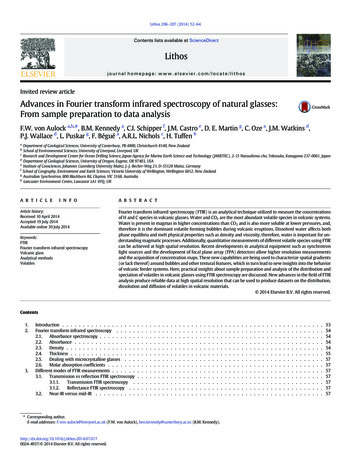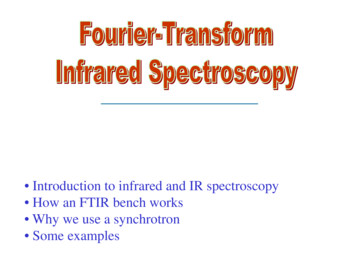
Transcription
FTIR- Fourier Transform Infrared SpectroscopyM.Sc. Chemistry Practical InorganicChemistry (Paper- 4106)Semester- IVDr. Neeraj Kumar and Dr. Sanjay Kumar SarojInorganic Group- II1
IntroductionSpectroscopy is the study of the interactionbetween matter and electromagnetic spectrum. Electromagnetic radiation displays the properties of bothparticles and waves. The particle component is called a photon. The energy (E) component of a photon is proportional to thefrequency. Where h is Planck’s constant and n is the frequencyin Hertz (cycles per second)E hnalso E hc/λ
Infrared spectroscopy (IR spectroscopy) is the spectroscopy thatdeals with the infrared region of the electromagnetic spectrum.Frequency, n in Hz 1019 1017 1015 1013 1010 1050.01 cm100 mWavelength, l .0001 nmg-raysnuclearexcitation(PET) 0.01 nm10 ronicexcitation(p to p*)1000 ationRadioNuclear MagneticResonance NMR(MRI)
IR spectroscopy is an absorption technique. Absorption of infrared radiation brings about changes in molecularvibrations within molecules. So, it is a kind of vibrational spectroscopy. The frequency at which a particular bond absorbs infrared radiationwill be different over a range of bonds and modes of vibration dependingon atom size, bond length and bond strength.Hookes' Law
When can absorption occur?1. Infrared absorption only occurs when infrared radiation interacts witha molecule undergoing a permanent change in dipole.2. Infrared absorption only occurs when the incoming infrared photonhas sufficient energy for the transition to the next allowed vibrationenergy state.If these two rules are not met ,no absorption can occur. N2 or O2 has no infrared spectrum (no dipole change). CO does have.
Vibration Types There are two different types of vibrational modes.Vibrations can either involve a change in bond length(stretching) or bond angle (bending).Stretching VibrationsBending vibrations
Vibrational Modes1.Stretching – Vibration or oscillation along the line of the bond.HHCCHHasymmetricsymmetric2.Bending – Vibration or oscillation not along the line of the bond.HHHHCCCHHHHtwistscissorin plane rockn Asym n Sym n BendingCwagout of plane
What is FTIR Fourier-transforminfrared spectroscopy is a less intuitiveway to obtain the information. Rather than shining a monochromatic beam of light at thesample, this technique shines a beam containing manyfrequencies of light at once and measures how much ofthat beam is absorbed by the sample. Fourier transform is to transform the signal from the timedomain to its representation in the frequency domain. All FTIR spectrometers are based on the MichelsonInterferometer.
Instrumentation
Components of FTIRIR SourceSamplecompartmentDetector
IR sourceNernst Glowerheated rare earth oxide rod( 1500 K)1-50 µm(mid- to far-IR)Globarheated SiC rod ( 1500 K)1-50 µm(mid- to far-IR)Tungsten filamentlamp1100 K0.78-2.5 µm(Near-IR)Hg arc lampplasma50 - 300 µm(far-IR)CO2 laserstimulated emission lines9-11 µm
The Sample Analysis ProcessInterferogram : intensity vs timeafter the Fourier transformation: intensity vs frequency:-an IRspectrum
Theory and Instrumentation The light originates from the He-Ne laser. Half of the light is reflected 90 degrees and hits a fixedmirror, while the other half passes through the beam splitterand hits the moving mirror. The split beams are recombined, but having traveleddifferent distances, they exhibit an interference pattern witheach other. As they pass through the sample, the detector collects theinterfering signals and returns a plot known as aninterferogram.
Stationary mirrorHeNe laserBeam SplitterSourceMoving mirrorPMTSampleDetector
Optical Diagram ofMichelson InterferometerLightsourceMovable mirrorHe-Ne gas laserBeam splitterInterferogramSample chamberDLATGS (deuterated LFixed mirrorDetectoralanine doped triglycenesulphate)Interferometer15
Interference Of Two FrequenciesMovable mirrorFixed mirrorMovable mirror-2lSame-phase-l0l2lContinuous phase shiftFixed mirrorMovable mirrorSignal strengthOpposite-phaseFixed mirrorMovable mirrorSame-phase0-2l-l0l2llInterference pattern of light manifested by the optical-path difference
DetectorsThe beam finally passes to the detector Thermal detectors Thermocouples Bolometer Photoconducting detectors most sensitive detectors. Pyroelectric detectors much faster response time insulator material Triglycine sulphate
Absorption Regions
Advantages of FT-IRSpeed Because all of the frequencies are measured simultaneously. Sensitivity is dramatically improved with FT-IR ; detectors are muchmore sensitive,higher signal to noise ratio. Mechanical Simplicity The moving mirror in the interferometer is theonly continuously moving part in the instrument. Thus, there is verylittle possibility of mechanical breakdown. Internally Calibrated These instruments employ a He-Ne laser as aninternal wavelength calibration standard .These instruments are selfcalibrating and never need to be calibrated by the user.20
Disadvantages of FTIR Cannot detect atoms or monoatomic ions - single atomicentities contain no chemical bonds. Cannot detect molecules comprised of two identicalatoms -such as N2 or O2. Aqueous solutions are very difficult to analyze- water is astrong IR absorber. Complex mixtures - samples give rise to complex spectra.21
Applications of FT-IR Pharmaceutical research Forensic investigations Polymer analysis Foods research Quality assurance and control Environmental and water quality analysismethods Biochemical and biomedical research coatings and surfactants
References Instrumental Methods of Analysis, Willard et al, 4th edition, CBSPublishers and Co. Fourier Transform Infrared Spectroscopy, Peter R. Griffiths, 2ndedition, John Wiley & Sons. http://www.photonics.com/Category.aspx?CatID 38300 .pdf23
What is FTIR Fourier-transform infrared spectroscopy is a less intuitive way to obtain the information. Rather than shining a monochromatic beam of light at the sample, this technique shines a beam containing many frequencies of light at once and measures how much of
